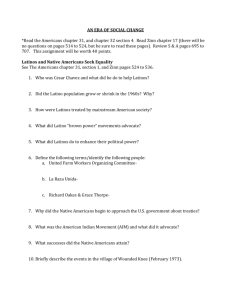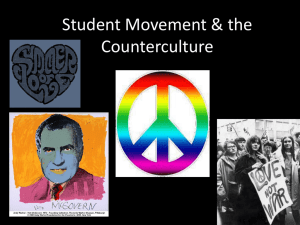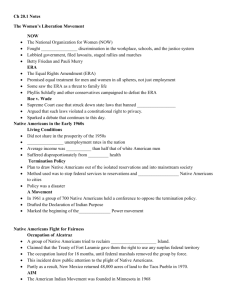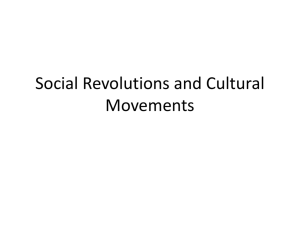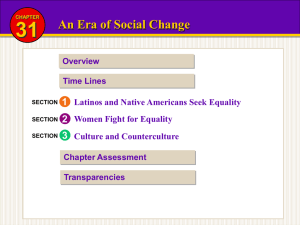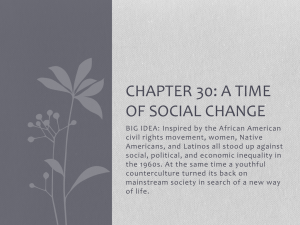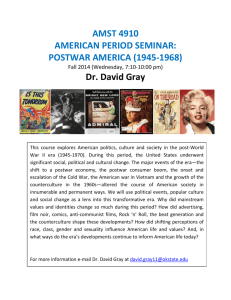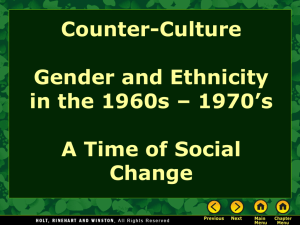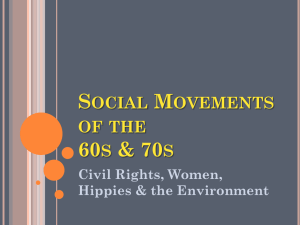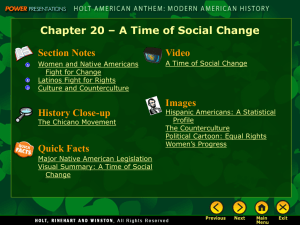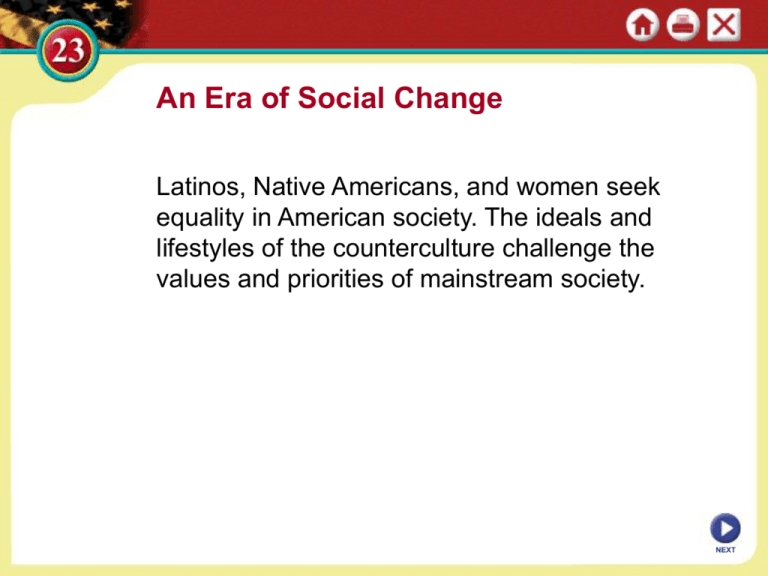
An Era of Social Change
Latinos, Native Americans, and women seek
equality in American society. The ideals and
lifestyles of the counterculture challenge the
values and priorities of mainstream society.
NEXT
An Era of Social Change
SECTION 1
Latinos and Native Americans Seek Equality
SECTION 2
Women Fight for Equality
SECTION 3
Culture and Counterculture
NEXT
Section 1
Latinos and Native
Americans Seek Equality
Latinos and Native Americans confront injustices
in the 1960s.
NEXT
SECTION
1
Latinos and Native Americans
Seek Equality
The Latino Presence Grows
Latinos of Varied Origins
• 1960s Latino population grows from 3 million to
9 million
• Mexican Americans largest group, mostly in
Southwest, California
• 1960, almost 900,000 Puerto Ricans settle in
U.S., mostly in NYC
• Cubans flee communism, form communities in
NYC, Miami, NJ
• Central Americans, Colombians come to escape
civil war, poverty
• Many Latinos encounter prejudice,
discrimination in jobs, housing
NEXT
SECTION
1
Latinos Fight for Change
The Farm Worker Movement
• César Chávez helps form United Farm Workers
Organizing Committee
• 1965 grape growers do not recognize union; Chávez
sets up boycott
• 1970 co-founder Dolores Huerta negotiates contract
Cultural Pride
• Puerto Ricans, Chicanos demand cultural
recognition, better schools
• 1968 Bilingual Education Act funds bilingual, cultural
programs
• Brown Berets organize walkouts in East LA high
schools
Continued . . .
NEXT
SECTION
1
Continued
Latinos Fight for Change
Political Power
• Latinos organize, help elect Latino candidates from
major parties
• League of United Latin American Citizens works for
rights since 1929
• La Raza Unida works on independent, Latino
political movement
- runs Latino candidates, wins in local races
• Reies Tijerina confronts government over farmers’
rights in NM
NEXT
SECTION
1
Native Americans Struggle for Equality
Native Americans Seek Greater Autonomy
• Many Native Americans cling to their culture,
refuse assimilation
• Native Americans poorest group, most
unemployment, health problems
• Termination policy relocates, does not solve
problems
• Native Americans call for economic opportunities
on reservations
• 1968 LBJ establishes National Council on Indian
Opportunity
Voices of Protest
• American Indian Movement (AIM)—Native
American rights organization
Continued . . .
NEXT
SECTION
1
continued
Native Americans Struggle for Equality
Confronting the Government
• 1972 AIM leads march in D.C.; protest treaty
violations, seek:
- restoration of land
- end of Bureau of Indian Affairs; occupy it,
destroy property
• 1973 AIM, Sioux seize Wounded Knee; violent
confrontation with FBI
Native American Victories
• 1970s laws give tribes more control over own
affairs, education
• 1970s–80s courts recognize tribal lands, give
financial compensation
NEXT
Section 2
Women Fight for Equality
Through protests and marches, women confront
social and economic barriers in American society.
NEXT
SECTION
2
Women Fight for Equality
A New Women’s Movement Arises
Women in the Workplace
• Women shut out of jobs considered “men’s work”
• Jobs available to women pay poorly
• JFK’s Presidential Commission on the Status of
Women finds:
- women paid far less than men for doing same job
- women seldom promoted to management positions
Continued . . .
NEXT
SECTION
2
continued
A New Women’s Movement Arises
Women and Activism
• In civil rights, antiwar movements men discriminate
against women
• Consciousness-raising groups show women pattern
of sexism in society
The Women’s Movement Emerges
• Betty Friedan’s The Feminine Mystique shows
women’s dissatisfaction
- bestseller, helps galvanize women across country
• Feminism—economic, political, social equality for
men, women
NEXT
SECTION
2
The Movement Experiences Gains and Losses
The Creation of NOW
• Civil rights laws, Equal Employment Opportunity
Commission help women
• 1966 National Organization for Women
(NOW) founded
• Presses for day-care centers, more vigorous
enforcement by EEOC
A Diverse Movement
• Militant groups like NY Radical Women stage
demonstrations
• Gloria Steinem helps found National Women’s
Political Caucus, Ms.
Continued . . .
NEXT
SECTION
2
continued
The Movement Experiences Gains and Losses
Legal and Social Gains
• Gender-based distinctions questioned—like
use of husband’s last name
• Higher Education Act bans gender
discrimination if federal funding
• Congress expands EEOC powers; gives childcare tax break
Roe v. Wade
• Feminist support of woman’s right to an
abortion is controversial
• Roe v. Wade: women have right to an abortion
in first trimester
Continued . . .
NEXT
SECTION
2
continued
The Movement Experiences Gains and Losses
The Equal Rights Amendment (ERA)
• 1972 Congress passes Equal Rights
Amendment (ERA)
• Phyllis Schlafly with religious, political groups
launch Stop-ERA
- think will lead to drafting women, end of child
support
The New Right Emerges
• Conservatives build “pro-family” movement,
later called New Right
• Focus on social, cultural, moral problems;
build grassroots support
• Debate family-centered issues with feminists
NEXT
SECTION
2
The Movement’s Legacy
The Movement Changes Society
• ERA defeated; only gets 35 of 38 states for
ratification by 1982
• Women’s movement changes roles, attitudes
toward career, family
• Education, career opportunities expand
- many women run into “glass ceiling”
• 1983, women hold 13.5% elected state offices,
24 seats in Congress
NEXT
Section 3
Culture and
Counterculture
The ideals and lifestyle of the counterculture
challenge the traditional views of Americans.
NEXT
SECTION
3
Culture and Counterculture
The Counterculture
“Tune In, Turn On, Drop Out”
• Counterculture—white, middle-class youths reject
traditional America
• Members of counterculture called hippies
• Feel society and its materialism, technology, war is
meaningless
• Idealistic youth leave school, work, home
- want to create idyllic communities of peace, love,
harmony
Continued . . .
NEXT
SECTION
3
continued
The Counterculture
Hippie Culture
• Era of rock ‘n’ roll, crazy clothing, sexual license,
illegal drugs
• Some hippies turn to Eastern religion, meditation
• Haight-Ashbury neighborhood of San Francisco
becomes hippie capital
Decline of the Movement
• Urban communes turn seedy, dangerous
• Some fall victim to drug addiction, mental
breakdowns
NEXT
SECTION
3
A Changing Culture
Art
• Pop art uses commercial, impersonal images
from everyday life
- imply that personal freedom lost to conformist
lifestyle
- movement led by Andy Warhol
Rock Music
• The Beatles most influential rock band, help
make rock mainstream
• Woodstock festival gathers many of most
popular bands
- over 400,000 attend
Continued . . .
NEXT
SECTION
3
continued
A Changing Culture
Changing Attitudes
• Attitudes toward sexual behavior become more
casual, permissive
• Mass culture addresses forbidden topics, like sex,
explicit violence
• Some think permissiveness is liberating; others
sign of moral decay
• Long term liberal attitudes about dress, lifestyle,
behavior adopted
NEXT
SECTION
3
The Conservative Response
Conservatives Attack the Counterculture
• Conservatives alarmed at violence on campuses,
cities
• Consider counterculture values decadent
• Some think counterculture irrational, favor senses,
lack inhibitions
NEXT
This is the end of the chapter presentation of
lecture notes. Click the HOME or EXIT button.
Print Slide Show
1. On the File menu, select Print
2. In the pop-up menu, select Microsoft PowerPoint
If the dialog box does not include this pop-up, continue
to step 4
3. In the Print what box, choose the presentation format
you want to print: slides, notes, handouts, or outline
4. Click the Print button to print the PowerPoint
presentation
BACK

